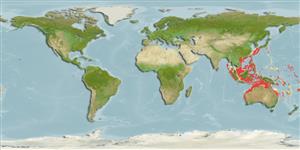>
Acropomatiformes (Oceanic basses) >
Champsodontidae (Crocodile toothfishes)
Etymology: Champsodon: Greek, champso = crocodile, voracious predator + Greek, odous = teeth (Ref. 45335); sagittus: Specific name refers to its pointed premaxillary symphysis and narrow, elongate body..
Environment: milieu / climate zone / depth range / distribution range
Οικολογία
Θαλασσινό(ά) βενθικό(ς); εύρος βάθους 0 - 433 m (Ref. 30434). Subtropical
Western Pacific: Australia, Indonesia, and the Philippines.
Μέγεθος / Βάρος / Age
Maturity: Lm ? range ? - ? cm
Max length : 7.7 cm SL αρσενικό/απροσδιόριστο; (Ref. 30434)
Ραχιαίες άκανθες (συνολικά) : 4 - 6; Μαλακές ραχιαίες ακτίνες (συνολικά) : 18 - 23; Μαλακές εδρικές ακτίνες: 16 - 21; Σπόνδυλοι: 29 - 33. First arch with 2 gill rakers on upper limb (Ref 12850).
Life cycle and mating behavior
Maturities | Αναπαραγωγή | Spawnings | Egg(s) | Fecundities | Προνύμφες
Nemeth, D., 1994. Systematics and distribution of fishes of the family Champsodontidae (Teleostei: Perciformes), with descriptions of three new species. Copeia 1994(2):347-371. (Ref. 30434)
IUCN Red List Status (Ref. 130435)
Threat to humans
Harmless
Human uses
Εργαλεία
Special reports
Download XML
Διαδικτυακές πηγές
Estimates based on models
Preferred temperature (Ref.
123201): 14.7 - 27.6, mean 22.4 °C (based on 638 cells).
Phylogenetic diversity index (Ref.
82804): PD
50 = 0.5002 [Uniqueness, from 0.5 = low to 2.0 = high].
Bayesian length-weight: a=0.00447 (0.00181 - 0.01102), b=3.12 (2.90 - 3.34), in cm total length, based on LWR estimates for this (Sub)family-body shape (Ref.
93245).
Τροφικό Επίπεδο (Ref.
69278): 3.9 ±0.5 se; based on size and trophs of closest relatives
Fishing Vulnerability (Ref.
59153): Low vulnerability (10 of 100).
